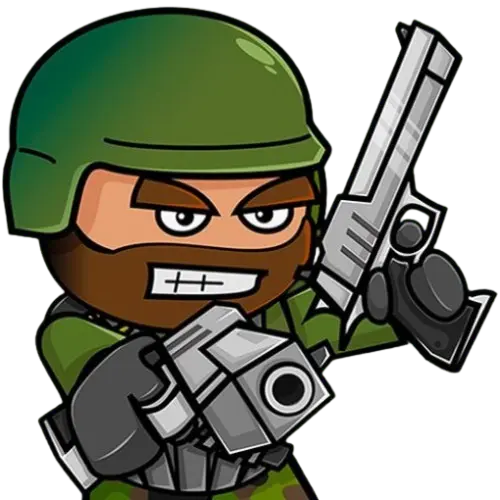Beyond the Basics: Advanced Tactics and Map Control Strategies for Dominating in Mini Militia
Anyone can learn to point and shoot in Mini Militia. But what separates the casual player from the true dominator is not just reflex; it’s strategy. To elevate one’s game, a player must move beyond simple brawling and master the deeper arts of movement, map control, and psychological warfare. This is a guide to those advanced tactics.
The Art of the Boost-Dodge: Mastering Evasive Maneuvers
Basic flying gets a player from point A to point B. Advanced boost control keeps them alive. The jetpack is not just a tool for transportation; it is the primary defensive weapon. Mastering the “boost-dodge” is the first step. This means using short, unpredictable bursts of boost to evade incoming fire, rather than long, straight lines of flight that make one an easy target. A skilled player can use the “boost-strafe,” moving erratically from side to side while still aiming at an opponent, making them incredibly difficult to hit. The key is to be constantly changing direction and speed. An unpredictable target is a surviving target. This level of fine control also allows a player to conserve boost fuel, ensuring they have an escape route ready when a fight turns against them.
Thinking in Choke Points: The Essence of Map Control
Amateur players chase kills. Professional players control the map. Every map in Mini Militia, from Outpost to Catacombs, is designed with “choke points”-narrow corridors or central areas where players are forced to pass through. Controlling these points requires a deep understanding of the game’s architecture. It’s a strategic skill that separates the pros from the casuals. Knowing the map, the weapon spawns, and the likely enemy routes is crucial. This level of game-specific knowledge is also essential for users of a modern entertainment platform like the desiplay betting app, where understanding the options and rules is key. In Mini Militia, this knowledge translates into a tactical advantage. A player who controls a key choke point can set up ambushes, pick off enemies as they approach, and ultimately dictate the flow and pace of the entire match. It’s the difference between reacting to the game and making the game react to you.
The Unspoken Language: Advanced Grenade and Melee Tactics
Secondary weapons are not just for emergencies; they are powerful strategic tools. Grenades, in the hands of an expert, are used more for area denial than for direct kills. A well-placed grenade can force an enemy out of a strong defensive position, flush them into the open, or block a passageway, allowing a player and their team to advance. The art of the “fly-by nade drop”-releasing a grenade while boosting directly over an unsuspecting enemy-is a high-level skill that can turn the tide of a fight. The melee attack is also more than just a last resort. It’s a silent and effective way to finish off a weakened opponent without wasting precious ammunition, and it can be used to instantly kill an opponent if one manages to get close enough before they can react.
Weapon Pairing and the ‘Quick Switch’ Advantage
Carrying the right tools for the job is essential. A common mistake is to carry two similar weapons. An advanced player, however, will almost always carry two complementary weapons. The classic pairing is a long-range, high-damage weapon (like a sniper rifle or shotgun) with a fast-firing, short-range weapon (like an Uzi or MP5). This allows them to be effective at all ranges. But the real advantage comes from the “quick switch” technique. This involves firing a single, powerful shot from a slow-firing weapon like the shotgun and then, instead of waiting for the cooldown, immediately switching to the Uzi to finish the opponent off with a quick burst. This classic first-person shooter tactic allows a player to maximize their damage output per second and win fights against opponents who are relying on just one weapon.
Psychological Warfare: Baiting and Predicting Opponents
The highest level of play happens not on the screen, but in the mind. It’s about out-thinking the opponent. A skilled player will use “baiting” tactics, such as intentionally firing a few shots to appear on the minimap, luring an overeager opponent into a carefully prepared ambush. They are masters of prediction. If a power-up like the damage boost spawns, they won’t just rush to it; they will predict the path an enemy will take to get it and intercept them. They pay attention to their opponents’ habits. Does a certain player always hide in the same spot? Does another always run away when their health gets low? Exploiting these predictable patterns is the key to dominating a match. The best players are not just reacting to what is happening; they are constantly thinking two or three steps ahead.
Conclusion: From Brawler to Grandmaster
Mini Militia is easy to learn but incredibly difficult to master. The difference between the average player and the elite is not just faster reflexes, but a deeper understanding of the game’s strategic layers. By mastering advanced movement, understanding and controlling the map’s choke points, using secondary weapons strategically, and learning to out-think the opposition, any player can begin their journey of transformation. It is the path from being a chaotic brawler who just looks for kills to becoming a strategic grandmaster who controls the entire battlefield. The true depth of the game is not in the shooting, but in the thinking.
